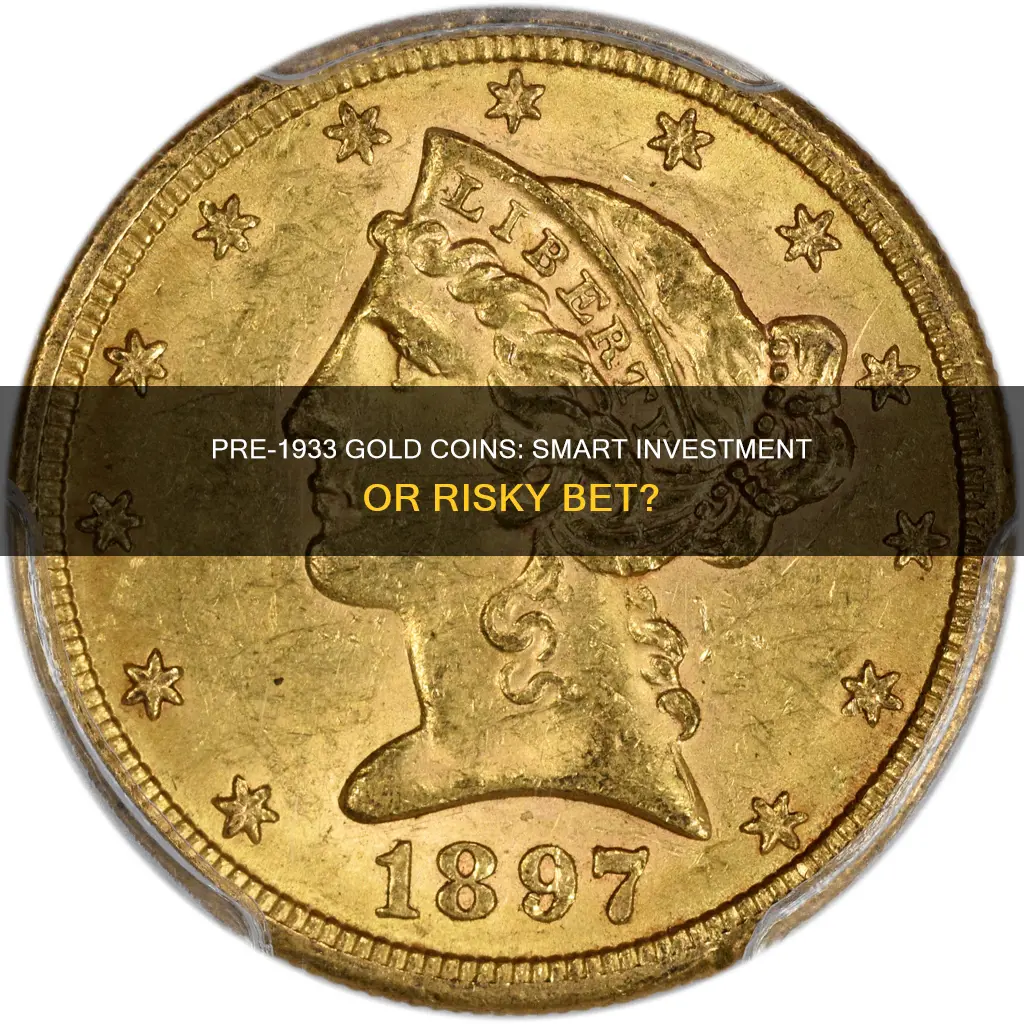
Pre-1933 gold coins refer to any legal tender gold coins produced before 1933. This was when circulating gold coinage in the United States came to an end, and the US government ceased minting gold as currency. Today, pre-1933 gold coins are sought-after by investors and collectors alike. Their value is determined by their gold content, condition, and rarity. With gold prices rising, investing in gold can be a good hedge against inflation. However, it is important to be cautious when purchasing pre-1933 gold coins as their historic nature does not necessarily make them rare or collectible.
What You'll Learn
- The value of pre-1933 gold coins is based on their gold content, condition, and rarity
- The gold content of pre-1933 coins was proportional to their denomination
- Common-date pre-1933 gold coins can be a good investment due to their fixed and limited supply
- Pre-1933 gold coins are in demand by both collectors and investors
- Raw pre-1933 gold coins can be a good sub-segment for further diversification

The value of pre-1933 gold coins is based on their gold content, condition, and rarity
Pre-1933 gold coins have a value based on a combination of their gold content, condition, and rarity. The gold content of these coins is a significant factor in determining their worth. From 1795 to 1833, US gold coins featured 22-karat gold content, with 91.67% gold and the remaining comprising silver and copper. In 1834, the gold content was lowered to 89.92%, and from 1837 onwards, the gold content was stabilized at 90%, with 10% consisting of an alloy of silver and copper. The weight and diameter of the coins also varied over time, with the US Eagle, for example, having a 33 MM diameter from 1795 to 1837, and a 27 MM diameter from 1838 to 1933.
The condition of pre-1933 gold coins is another factor influencing their value. Coins that are in better condition, with minimal wear and tear, will generally command higher prices. Additionally, the rarity of these coins plays a crucial role in their value. The Great Depression-era legislation by President Franklin Roosevelt, which prohibited citizens from holding monetary gold and recalled gold coins, resulted in many coins being melted down, making surviving pre-1933 gold coins scarce and highly sought-after by collectors and investors.
The historical significance of pre-1933 gold coins, particularly Liberty gold coins, also adds to their value. These coins embody a rich historical legacy, capturing the spirit and values of the time periods in which they were minted. Their designs often featured iconic American figures such as Lady Liberty and eagles, making them collectible items for those interested in the historical and cultural significance of coinage.
Overall, the value of pre-1933 gold coins is influenced by a combination of factors, including their gold content, condition, rarity, and historical significance. These vintage gold coins offer a unique opportunity for collectors and investors to embrace the past, preserve wealth, and indulge in the captivating world of numismatics.
The Ultimate Guide: Investing in Bitcoin
You may want to see also

The gold content of pre-1933 coins was proportional to their denomination
Pre-1933 gold coins refer to any legal tender gold coins made before 1933. This was when circulating gold coinage in the US ended, and the value of these coins is based on their gold content, condition, and rarity.
The US Mint started producing gold coins in 1795, two years after the Coinage Act was passed. The Mint initially focused on copper and silver coins, but by 1830, gold coins were being produced more widely. The Quarter Eagle, Half Eagle, and Eagle gold coins were introduced in 1795, with the Double Eagle following in 1850. The gold content of these coins was initially in line with their intrinsic worth, but today, the gold content alone is worth much more than the legal value.
The California Gold Rush of the late 1840s and early 1850s led to a heavy surplus of gold, which increased gold coin production. The US Eagle ($10), Half Eagle ($5), and Quarter Eagle ($2.50) were the first gold coins to be produced, followed by the Double Eagle ($20) in 1850. The gold content of these coins was proportional to their face value. For example, the US Eagle had twice as much gold as the Half Eagle, and four times that of the Quarter Eagle.
Over time, the gold content of pre-1933 coins changed. From 1795 to 1833, US gold coins featured 22-karat gold content, with 91.67% gold, and some combination of silver and copper making up the rest. From 1834 to 1836, the gold content was lowered to 89.92% to prevent merchants from melting down and exporting US gold coins. In 1837, the gold content was stabilised at 90% gold and 10% alloy, with silver removed from the alloy by 1841.
The US Eagle had a diameter of 33mm from 1795 to 1837, which was reduced to 27mm from 1838 to 1933. The US Half Eagle had a diameter of 25mm from 1795 to 1828, which was reduced to 23.8mm from 1829 to 1833, then to 22.5mm from 1834 to 1865, and finally to 21.6mm from 1866 to 1929. The US Quarter Eagle had a diameter of 20mm from 1796 to 1820, which was reduced to 18.5mm from 1821 to 1828, then to 18.2mm from 1829 to 1839, and finally to 18mm from 1840 onwards. The US Double Eagle had a diameter of 34mm, which remained unchanged.
Pre-1933 gold coins are a good investment because they are rare and have both numismatic and investment appeal. They offer a unique combination of historical significance, scarcity, and intrinsic value. Their limited availability makes them highly sought after by collectors and investors.
How Much Money Do Bitcoin Investors Typically Risk?
You may want to see also

Common-date pre-1933 gold coins can be a good investment due to their fixed and limited supply
The value of pre-1933 gold coins is based on their gold content, condition, and rarity. While some coins are prized by collectors, most are not, and investors should be cautious of paying high mark-ups for "rare" coins. Common-date gold coins are typically priced between $600 and $2,500 per coin, offering an excellent entry point for investors looking to add gold to their portfolios.
It's important to note that the larger coins ($20 and $10 denominations) offer similar gold content and exposure to rising gold prices as modern bullion coins. Additionally, their fixed and limited supply means they have better prospective profits than modern gold bullion alone.
When investing in pre-1933 gold coins, it's recommended to focus on coins in the investment-grade range from MS-62 to MS-66 for the best value and upside potential. These coins are in high demand by both collectors and investors, and their fixed and limited supply means they can rise in value quickly when demand increases.
Overall, common-date pre-1933 gold coins can be a smart investment choice due to their fixed and limited supply, offering investors a way to leverage their holdings in the precious metals market.
Is Bitcoin Gold a Safe Investment Bet?
You may want to see also

Pre-1933 gold coins are in demand by both collectors and investors
The main types of Pre-1933 gold coins are common-date gold coins and rare-date coins. Common-date gold coins are typically more affordable and have a higher number of known survivors, either from a high mintage or survival rate. Rare-date coins, on the other hand, are scarcer and have a lower number of known survivors. Both types of coins feature designs from the same era.
The value of Pre-1933 gold coins is based on a number of factors, including their gold content, condition, and rarity. The gold content of these coins was proportional to their denomination, with higher denominations containing more gold. The condition of the coins is also important, with uncirculated or certified coins tending to be more valuable. Additionally, certain rare coins from this era, such as the 1933 double eagle, may be worth more due to their scarcity.
It is important to note that not all Pre-1933 gold coins are rare or valuable. Unethical dealers may prey on the misconception that these coins are rare, as they have not circulated for almost 100 years. However, most of these coins are not prized by collectors, and investors should be cautious of paying big mark-ups.
Overall, Pre-1933 gold coins can be a good investment option, particularly for those looking to diversify their portfolios and add leverage in a rising gold market. Their fixed and limited supply, as well as their demand from both collectors and investors, make them an attractive choice. However, it is important to do your research and understand the market before investing in these coins.
Bitcoins: Investment Opportunities, Pros, and Cons
You may want to see also

Raw pre-1933 gold coins can be a good sub-segment for further diversification
Rarity and Exclusivity:
Pre-1933 gold coins are characterised by their limited availability and scarcity. Executive Order 6102, issued in 1933, prohibited private ownership of gold, resulting in most gold coins being withdrawn from circulation and melted down. This has made surviving pre-1933 gold coins relatively rare and highly sought-after by collectors and investors. Their extreme rarity, coupled with high demand, makes them a valuable addition to any investment portfolio.
Historical Significance:
Pre-1933 gold coins, especially Liberty gold coins, hold a special place in the history of numismatics and investment. These vintage gold coins, minted before the gold recall of 1933, offer a unique blend of historical context, rarity, and intrinsic value. They embody the spirit and values of the time, reflecting the growth and development of the United States as a nation. Their designs often feature iconic American figures, such as Lady Liberty, eagles, and other patriotic elements, making them culturally significant.
Investment Potential:
From an investment perspective, pre-1933 gold coins offer enduring value. Made of 90% pure gold, they provide a tangible and stable investment in precious metals. The scarcity and historical significance of these coins contribute to their numismatic premium, which can exceed the value of their gold content. The 1933 $20 gold coin, for example, has achieved legendary status among collectors and investors due to its rarity and stunning design.
Denomination Variety:
Pre-1933 gold coins offer a range of denominations, including $1, $2.50, $5, $10, and $20 coins. This variety provides buyers with options that can fit within their budget or investment strategy. Each denomination has its own unique story and historical significance, adding depth and value to any collection or investment portfolio.
Collectible Appeal:
The collectible appeal of pre-1933 gold coins further enhances their significance. Collectors are drawn to the artistry, craftsmanship, and historical context of these vintage coins. Each coin carries a unique story, adding intrigue and timeless value beyond mere financial worth. The thrill of acquiring and owning these rare treasures is a driving force for many collectors.
In summary, raw pre-1933 gold coins can be an excellent choice for investors seeking further diversification. Their rarity, historical significance, investment potential, denomination variety, and collectible appeal make them a valuable and intriguing addition to any investment portfolio or collection.
Coinbase: Should You Invest Pre-IPO?
You may want to see also







